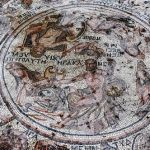 Music
Music  Music
Music  History
History 10 Less Than Jolly Events That Occurred on December 25
 Weird Stuff
Weird Stuff 10 Funny Ways That Researchers Overthink Christmas
 Politics
Politics 10 Political Scandals That Sent Crowds Into the Streets
 Weird Stuff
Weird Stuff Ten Bizarre Facts About The Doge Meme
 Our World
Our World 10 Ways Your Christmas Tree Is More Lit Than You Think
 Movies and TV
Movies and TV The 10 Coolest Stars to Set Sail on The Love Boat
 History
History 10 Things You Didn’t Know About the American National Anthem
 Technology
Technology Top 10 Everyday Tech Buzzwords That Hide a Darker Past
 Humans
Humans 10 Everyday Human Behaviors That Are Actually Survival Instincts
 Music
Music 10 Surprising Origin Stories of Your Favorite Holiday Songs
 History
History 10 Less Than Jolly Events That Occurred on December 25
 Weird Stuff
Weird Stuff 10 Funny Ways That Researchers Overthink Christmas
Who's Behind Listverse?

Jamie Frater
Head Editor
Jamie founded Listverse due to an insatiable desire to share fascinating, obscure, and bizarre facts. He has been a guest speaker on numerous national radio and television stations and is a five time published author.
More About Us Politics
Politics 10 Political Scandals That Sent Crowds Into the Streets
 Weird Stuff
Weird Stuff Ten Bizarre Facts About The Doge Meme
 Our World
Our World 10 Ways Your Christmas Tree Is More Lit Than You Think
 Movies and TV
Movies and TV The 10 Coolest Stars to Set Sail on The Love Boat
 History
History 10 Things You Didn’t Know About the American National Anthem
 Technology
Technology Top 10 Everyday Tech Buzzwords That Hide a Darker Past
 Humans
Humans 10 Everyday Human Behaviors That Are Actually Survival Instincts
10 Riveting U.S. Classified Secrets Revealed
U.S. classified documents are accorded legal protection, from their lowest to their highest security levels, as “confidential,” “secret,” or “top secret.” Classified documents contain information that, if disclosed publicly, would damage the nation’s security. The same is true with regard to secret documents, except that the damage to national security would be more serious. The public disclosure of top-secret documents would cause exceptionally grave damage to national security.
From time to time, such documents are declassified. Then, they often appear on websites or in other sources and are subject to academic, journalistic, and public scrutiny. Many times, what they reveal, typically years after the events with which they are concerned have transpired, is riveting or even shocking.
So let’s look at the 10 secrets that declassified U.S. documents revealed.
Related: Top 10 Reasons The U.S. Government Is No Longer Laughing About UFOs
10 Pegasus Spies on Mexican President Obrador’s Administrators
According to declassified documents, Alejandro Encinas, Mexico’s Undersecretary for Human Rights, advised President Lopez Obrador that Pegasus spyware had been found on Encinas’s own cellphone and those of two others in his office. Encinas had been investigating the mysterious “disappearances of hundreds of people,” a New York Times article explains, which occurred during the “Dirty War” that the Mexican military conducted in the 1960s and 1970s against a left-wing insurgency.
Initially, U.S. officials considered the Mexican crackdown to be understandable, Kate Doyle reports in her 2003 article “Human Rights and the Dirty War in Mexico.” And the U.S. assured Mexico that it “had no intention of pressing [Mexican President Luis] Echeverría about it.”
However, this stance changed in 1978, when U.S. President Jimmy Carter ordered the White House to conduct a sweeping review of U.S.-Mexican relations and learned that “the White Brigade and other security force elements… sometimes ignored [both] the human rights of [terrorist] suspects and Mexican judicial procedures,” torturing and executing such individuals, with the results that “200-300 persons [had disappeared] over the last decade.”
Only now, three decades later, is Mexico beginning to come to grips with the fact that the government was responsible for “torturing and murdering its own people.”[1]
9 Spy Satellite Recovery Operation
In April 1972, when a “data package” sank into the Pacific Ocean, the U.S. Navy dispatched the Trieste II Deep Sea Vehicle I (DSV-1), its most advanced deep sea submersible at the time, to recover the item. In reality, it was “part of a film capsule from an American photoreconnaissance [spy] satellite codenamed HEXAGON.”
According to the Freedom of Information Act Electronic Reading Room, a malfunction was responsible for the incident. A parachute was supposed to deploy once the film capsule, or “bucket,” having reentered the atmosphere, was over the primary reentry zone near the Hawaiian Islands. Instead, the parachute broke off, and the bucket fell into the ocean, sinking on impact to a depth of about 16,400 feet (5,000 meters).[2]
8 Project Cloud Gap
In January 1969, the United States Arms Control and Disarmament Agency released Volume 1 of its “Final Report” on a field test involving the “Demonstrated Destruction of Nuclear Weapons.” The field test’s purpose, the publication’s abstract states, was to “develop and test inspection procedures to monitor the demonstrated destruction of nuclear weapons.” In addition, a goal of the test was to determine the extent to which the “proposed method of demonstrating destruction” would expose classified weapon information. The test included 40 actual nukes and 32 fake weapons.
As a result of the test, it was concluded that the proposed destruction techniques could, indeed, reveal classified information about the weapons’ design. However, by masking some of the weapons’ features and limiting inspectors’ visual examinations of the weapons, such disclosures could be prevented.
The inspectors’ poor ability to distinguish between bona fide and fake nukes might also conceal classified information, as could “evasion schemes,” suggesting that less U-235 was being used than was actually the case. The field tests suggested that, overall, the inspection procedures were reasonably secure but resulted in several recommendations for the conduct of such inspections.[3]
7 Missile Gap
During the Cold War, the West became concerned that the USSR was outpacing the U.S. in the production of intercontinental-range ballistic missiles (ICBMs). The perceived “missile gap” between NATO and the USSR prompted both the Eisenhower and the Kennedy administrations to accelerate ICBM production until technological breakthroughs and innovative aerial and satellite photography eventually provided the CIA with a more accurate assessment of Soviet missile capacity, allowing policymakers to shift gears.
Declassified documents reveal details of the erroneous estimates of the size of the Soviet ICBM arsenal and the concern it caused Western nations.[4]
6 CIA Stay-Behind Ops
According to Timothy Naftali of the University of Virginia, between 1949 and 1955, the U.S. Central Intelligence Agency (CIA) operated a stay-behind network of German agents. They consisted of two programs—the Kinitz, in Southwestern Germany, and the Pastime, in Berlin—to provide intelligence sources behind the lines should the Soviets invade West Germany.
During the operation, several stay-behind agents proved problematic, one group displaying “Nazi tendencies.” As a result, the CIA initiated a program to “resettle” them in Canada and Australia, the latter country volunteering to pay their travel costs while the U.S. would give them and those who resettled in Canada a resettlement bonus.[5]
5 Berlin Wall
Built in 1961, the Berlin Wall separated East Berlin from West Berlin until 1989. It was meant to isolate and destroy the small oasis of freedom that the Wall surrounded. Instead, the Wall became a political hot spot that escalated tensions between the U.S., Europe, and the USSR.
A number of declassified documents related to the Wall disclose how the U.S. reacted to USSR threats to isolate West Germany before the building of the Wall and the West’s attempts to reunite East Berlin and West Berlin after the building of the Wall.[6]
4 Bay of Pigs
Official History of the Bay of Pigs Operation, written by CIA staff historian Jack Pfeiffer, originally designated as top secret, remained unfinished at the time of the author’s retirement. Its fifth volume, deemed to have serious shortcomings in scholarship, remains unpublished.
It is clear, from reading Part 1 of Volume 1, that the 1961 covert military operation designed to overthrow Cuba’s Fidel Castro was, from the U.S. perspective, a disaster. One account claims that the operation failed because it excluded strikes against any tactical air targets. A second account states that President John F. Kennedy called off the second strike after forgetting it had been planned. Which “version” is “more precise” could never be determined, Pfeiffer concludes. The second part of the volume provides participants’ reactions to the failed operation. It also lists source material.
As Pfeiffer’s Foreword to Part 1 of Volume 2 indicates, this document focuses on the CIA’s “participatory role in the formulation of United States foreign policy” toward Guatemala and Nicaragua during the course of the operation. Part 2 of the volume is an appendix to Part 1 and reproduces four memorandums and an excerpt from an interview with John J. Muccio, the Ambassador to Guatemala at the time.
Volume 3’s contents are described by its title: “Evolution of CIA’s Anti-Castro Policies, 1959-January 1961.”
Volume 4 is devoted to the point of view of CIA personnel who were “closely involved in the Bay of Pigs (BOP) operation.” Their perspective can be summed up as feeling, as Pfeiffer writes, that they received a “bum rap,” as they were blamed as scapegoats for a political decision that undermined the success of the mission, in part to protect “the Kennedy image.”
The unpublished fifth volume represents an extended after-action report of sorts, focusing on evaluations of the operation and includes a chapter devoted to “Evaluation of the Evaluations.”[7]
3 Project 1794
The cutaway diagram of the declassified U.S. Air Force aircraft on the drawing board in the 1950s certainly looks like a flying saucer. Driven, it appears, by a central turbine engine mounted in the center of its disk-shaped body, the object also looks like it’s built to hover, streak off at high speed, shoot upward, and change direction abruptly.
As Live Science’s article concerning the strange craft points out, it would be produced during Project 1794 and “capable of traveling at supersonic speeds at high altitudes.” In fact, its specifications call for it to be able to attain a speed of Mach 4 and to reach an altitude of 100,000 feet (30,480 meters). It would have to be fast; its mission would be to shoot down Soviet bombers. The Pentagon was betting heavily on the saucer-shaped aircraft; $3 million was awarded for the production of a prototype.
The project was canceled, though, in 1961, when tests suggested that the “flying saucer design was aerodynamically unstable” and would likely be uncontrollable at high or supersonic speeds.[8]
2 Wired Kitties
As Kat Eschner writes for Smithsonian Magazine, during the 1960s, the CIA investigated the use of such animals as ravens, pigeons, and cats for espionage purposes. As naturally curious creatures, cats would be perfect spies, it was thought, for the U.S.’s Project Acoustic Kitty. The felines could be implanted with recording devices, their apparent wanderings directed by audio cues. With cats recording Soviet leaders’ every word, their conversations would no longer be covert.
The idea may seem amusing, but it was monstrous, says Victor Marchetti, a former assistant to the CIA’s director: “They slit the cat open, put batteries in him, [and] wired him up. They made a monstrosity.”
At the time, developing sophisticated technology was no simple task, and the project took five years to complete, including the time spent testing the technology on “dummies and live animals.” The project seemed doomed from the beginning: the first cat to be deployed was killed when it crossed a street and was struck by a taxi cab.
The kitties’ career as spies ended in 1967, when the CIA finally acknowledged that, despite using a “$20 million feline radio transmitter,” cats, as Eschner puts it, “really don’t take direction well.”[9]
1 Civilian Murders and Prisoner Torture in Vietnam
Many may believe that the infamous 1968 My Lai massacre was the extent of the atrocities committed by U.S. forces during the Vietnam War. However, declassified Army documents, part of a previously secret 9,000-page archive assembled by a Pentagon task force, indicate that the same company of soldiers who killed “anything that moved” at My Lai also committed numerous other barbaric acts.
As a Los Angeles Times article points out, Vietnamese families were “attacked in their homes, farmers in rice paddies, teenagers out fishing… [as] a violent minority murdered, raped, and tortured with impunity.” Such atrocities were not limited to only one unit but were found in every Army division that operated in Vietnam.
Verified as having happened are such crimes as seven massacres resulting in at least 137 deaths; seventy-eight “other attacks” resulting in at least 57 deaths, 56 wounded, and 15 sexually assaulted; and nearly 150 incidents of the torture of prisoners of war “with fists, sticks, bats, water or electric shock.”[10]








